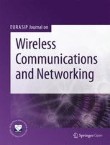EURASIP Journal on Wireless Communications and Networking welcomes submissions to the special issue on Physical Layer Security Solutions for 5G-and-Beyond.
It is foreseen that in the next few years we will witness major leaps in the area of quantum computing, with serious implications for the domain of security. For example, NIST key management guidelines suggest that RSA keys lengths of more than 15,360-bits are necessary to attain a security strength similar to AES-256, and a selection process has been initiated by NIST to choose new post-quantum cryptographic primitives. On the other hand, with 5G on the verge of being launched, ultra-low delays are envisioned and become critical in a growing number of emerging applications. In this context, the increasing complexity and related overhead of quantum resistant cryptographic schemes may clash with one of the central requirements of 5G and beyond (B5G) systems to connect people, machines and ultimately everything with diminishing delays and increasing autonomy. Currently, there is an intense discussion in progress in the wireless community on possible alternative approaches to secure the 5G and B5G wireless edge, building on the premise that the properties of the wireless medium can be exploited in building novel security approaches. Similar arguments hold for Internet of Things (IoT) devices and applications. The area of physical layer security (PLS) is gaining momentum in this framework, with the hope that it can play a vital role in reducing both the latency as well as the complexity of novel security standards. The aspiration of the present special issue is to provide the platform for presenting cutting-edge novel results in PLS and its potential application in B5G systems, as well as high quality tutorial articles on related topics. The focus of this publication is on the integration of PLS into actual systems and the potential benefits in securing emerging systems, including, but not limited to, enhanced mobile broadband (eMBB), ultra-reliable low-latency communications (URLLC), massive machine type communications (mMTC), Internet of Things (IoT), visible light communications (VLC), near field communications (NFC), etc.
Topics of interest include but are not limited to:
- The application of PLS in 5G-and-beyond networks, eMBB, URLLC, mMTC
- PLS for massive MIMO / NOMA / mmWave
- Advances in secret key generation and applications
- Cross-layer security protocols and approaches
- Physical-layer enhanced cryptography
- Covert communications and practical applications
- Secrecy analysis and enhancement in PLS
- Adaptive communication / jamming enabled confidentiality enhancement
- Advances in private information retrieval and applications in edge / fog computing
- Physical layer authentication and location verification
- PLS in IoT systems
- PLS for VLC, NFC, RF-ID etc.
- Prototypes, experimental results, demonstrators
Submission Instructions
Before submitting your manuscript, please ensure you have carefully read the submission guidelines for EURASIP Journal on Wireless Communications and Networking. The complete manuscript should be submitted through the EURASIP Journal on Wireless Communications and Networking submission system. To ensure that you submit to the correct special issue please select the appropriate special issue in the drop-down menu upon submission. In addition, indicate within your cover letter that you wish your manuscript to be considered as part of the special issue on Physical Layer Security Solutions for 5G-and-Beyond. All submissions will undergo rigorous peer review and accepted articles will be published within the journal as a collection.
Deadline for submissions: 1 November 2019
Lead Guest Editor
Arsenia Chorti, Ecole Nationale Supérieure de l'Electronique et de ses Applications (ENSEA), France
Guest Editors
Stefano Tomasin, University of Padova, Italy
H. Vincent Poor, Princeton University, US
Marco Baldi, Università Politecnica delle Marche, Italy
Salim El Rouayheb, Rutgers University, US
Xianbin Wang, Western University, Canada
Submissions will also benefit from the usual advantages of open access publication:
- Rapid publication: Online submission, electronic peer review and production make the process of publishing your article simple and efficient
- High visibility and international readership in your field: Open access publication ensures high visibility and maximum exposure for your work - anyone with online access can read your article
- No space constraints: Publishing online means unlimited space for figures, extensive data and video footage
- Authors retain copyright, licensing the article under a Creative Commons license: articles can be freely redistributed and reused as long as the article is correctly attributed
Sign up for article alerts to keep updated on articles published in EURASIP Journal on Wireless Communications and Networking - including articles published in this special issue!
